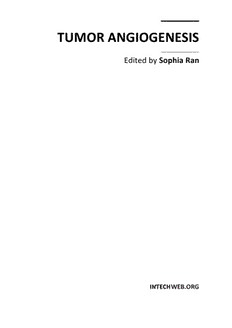Table Of ContentTUMOR ANGIOGENESIS
Edited by Sophia Ran
Tumor Angiogenesis
Edited by Sophia Ran
Published by InTech
Janeza Trdine 9, 51000 Rijeka, Croatia
Copyright © 2012 InTech
All chapters are Open Access distributed under the Creative Commons Attribution 3.0
license, which allows users to download, copy and build upon published articles even for
commercial purposes, as long as the author and publisher are properly credited, which
ensures maximum dissemination and a wider impact of our publications. After this work
has been published by InTech, authors have the right to republish it, in whole or part, in
any publication of which they are the author, and to make other personal use of the
work. Any republication, referencing or personal use of the work must explicitly identify
the original source.
As for readers, this license allows users to download, copy and build upon published
chapters even for commercial purposes, as long as the author and publisher are properly
credited, which ensures maximum dissemination and a wider impact of our publications.
Notice
Statements and opinions expressed in the chapters are these of the individual contributors
and not necessarily those of the editors or publisher. No responsibility is accepted for the
accuracy of information contained in the published chapters. The publisher assumes no
responsibility for any damage or injury to persons or property arising out of the use of any
materials, instructions, methods or ideas contained in the book.
Publishing Process Manager Molly Kaliman
Technical Editor Teodora Smiljanic
Cover Designer InTech Design Team
First published February, 2012
Printed in Croatia
A free online edition of this book is available at www.intechopen.com
Additional hard copies can be obtained from [email protected]
Tumor Angiogenesis, Edited by Sophia Ran
p. cm.
ISBN 978-953-51-0009-6
Contents
Preface IX
Chapter 1 Heparin-Like Drugs with Antiangiogenic Activity 1
María Rosa Aguilar, Luis García-Fernández,
Raquel Palao-Suay and Julio San Román
Chapter 2 Regulation of Angiogenesis in Human Cancer via Vascular
Endothelial Growth Factor Receptor-2 (VEGFR-2) 27
Shanchun Guo, Laronna S. Colbert,
Tanisha Z. McGlothen and Ruben R. Gonzalez-Perez
Chapter 3 The Effect of Chinese Herb on Tumor
Angiogenesis by Inhibiting Vessel Endothelial Cells 67
Jian Jin, Li-Ying Qiu, Hui Hua and Lei Feng
Chapter 4 Beyond VEGF: The NOTCH and ALK1 Signaling
Pathways as Tumor Angiogenesis Targets 85
Olivier Nolan-Stevaux and H. Toni Jun
Chapter 5 Platelet Regulation of Angiogenesis,
Tumor Growth and Metastasis 115
Jessica Cedervall and Anna-Karin Olsson
Chapter 6 Malignant Transformation in Skin is Associated
with the Loss of T-Cadherin Expression in Human
Keratinocytes and Heterogeneity in T-Cadherin
Expression in Tumor Vasculature 135
Kseniya Rubina, Veronika Sysoeva, Ekaterina Semina,
Natalia Kalinina, Ekaterina Yurlova, Albina Khlebnikova
and Vladimir Molochkov
Chapter 7 Modeling Tumor Angiogenesis in Zebrafish 167
Massimo M. Santoro
Chapter 8 The Role of VEGF in the Process of Neovasculogenesis 181
Aleksandra Sobczyńska-Rak
VI Contents
Chapter 9 Cancer Related Inflammation and Tumor Angiogenesis 197
Ping Wu
Chapter 10 Infantile Hemangiomas: A Disease Model in
the Study of Vascular Development, Aberrant
Vasculogenesis and Angiogenesis 213
Alvin Wong and June K. Wu
Chapter 11 MicroRNAs Regulation of Tumor Angiogenesis 231
Munekazu Yamakuchi
Chapter 12 New Molecular Targets for Anti-Angiogenic
Therapeutic Strategies 249
Amanda G. Linkous and Eugenia M. Yazlovitskaya
Chapter 13 Molecular Mechanisms of Tumor Angiogenesis 275
Kelly Burrell and Gelareh Zadeh
Preface
Angiogenesis is the main process responsible for formation of new tumor blood that play
an essential role in expansion of the tumor mass and dissemination of metastatic cells.
Tumor angiogenesis significantly differs from the tightly controlled normal
neovascularization driven by physiological needs. This is because the tumor
environment contains excessive levels of vascular endothelial growth factor-A (VEGF-A)
as well as many other pro-angiogenic factors that are produced by neoplastic, stromal,
and infiltrating immune cells. This imbalance of pro-angiogenic versus anti-angiogenic
factors promotes generation of numerous but abnormal blood vessels that exhibit severe
structural and functional defects. The chaotic and poorly-perfused tumor vascular
network creates a chronically inflamed site that promotes thrombosis, and impedes drug
delivery, causing further complications to the cancer patient. Most importantly, the
structural and functional abnormalities of tumor vessels promote hematogenous
metastasis, which is the main cause for decreased survival of patients with solid tumors.
It is, therefore, not surprising that tumor angiogenesis is regarded as an important target
for developing anti-cancer strategies with many studies focused on mechanisms of the
tumor blood vessel formation and their impact on tumor pathology and progression.
This book covers a variety of topics related to the biology of tumor vasculature. This
includes reviews on VEGF-A-dependent and independent mechanisms controlling the
formation of new vessels; contribution of inflammatory cells and platelets to tumor
neovascularization; identification of new molecular targets for inhibition of tumor
angiogenesis; and potential clinical use of novel anti-angiogenic therapies based on
heparin-like compounds and Chinese herbal extracts. The book covers also two
emerging subjects in the field: a recently developed zebrafish model of tumor
angiogenesis, and microRNA regulation of blood vessel formation at the tumor site.
Collectively, the chapters in the book provide a current update on central findings in the
tumor angiogenesis field, while highlighting potential targets for inhibition. We hope
that this book will be useful for oncologists, cancer basic researchers, and biologists with
interests in vascular and endothelial cell behavior in the context of cancer.
Sophia Ran, Ph.D.
Associate Professor
Southern Illinois University, School of Medicine
Springfield, IL
USA

